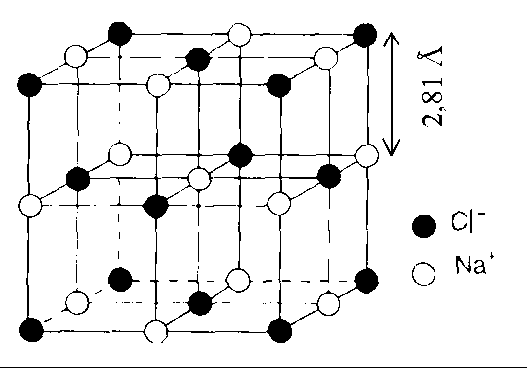Answer
395.4k+ views
Hint: We must know that the structure of \[{\text{NaCl}}\] crystal is face-centred cubic (FCC) type cubic lattice. In the (FCC) arrangement, there is one additional atom at the centre of each of the six faces of the unit cube.
Complete step by step answer:
See the figure; we can clearly see that, each edge contains two \[{\text{C}}{{\text{l}}^{\text{ - }}}\]ions and one \[{\text{N}}{{\text{a}}^{\text{ + }}}\] ion.

So, we know that the edge length = \[\]${\text{rN}}{{\text{a}}^{\text{ + }}}{\text{ + 2rC}}{{\text{l}}^{\text{ - }}}{\text{ + rN}}{{\text{a}}^{\text{ + }}}$
Or, edge length = ${\text{2rN}}{{\text{a}}^{\text{ + }}}{\text{ + 2rC}}{{\text{l}}^{\text{ - }}}$
In the question, they given edge length = \[{\text{564pm}}\]
Also ionic radius of sodium, ${\text{rC}}{{\text{l}}^{\text{ - }}}$\[{\text{ = 181pm}}\]
\[2rC{l^ - } = 2 \times 181 = 362\]
Now, we can substitute the values in edge length equation,
\[{\text{564pm = 2rN}}{{\text{a}}^{\text{ + }}}{\text{ + 362}}\]
\[
{\text{564pm - 362pm = 2rC}}{{\text{l}}^{\text{ - }}} \\
{\text{202pm = 2rC}}{{\text{l}}^{\text{ - }}} \\
{\text{rC}}{{\text{l}}^ - } = \dfrac{{{\text{202pm }}}}{2} = 101{\text{pm}} \\
\]
So, we found the ionic radius of sodium ion is\[{\text{101 pm}}\].
Hence, the correct option is option A.
Additional information:
1. Lattice structures are three-dimensional structures composed of one or more repeating unit cells. We can classify the cubic lattices as three types such as simple cubic (SC), body-centred cubic (BCC), and face-centred cubic (FCC).
2. The FCC has a coordination number of 12 and contains 4 atoms per unit cell. The BCC has a coordination number of 8 and contains 2 atoms per unit cell. The simple cubic has a coordination number of 6 and contains 1 atom per unit cell.
3. Sodium chloride has a molar mass of \[58.44{\text{ }}g/mol\]. It is an ionic compound consisting of a sodium cation (\[N{a^ + }\]) and a chloride anion (\[C{l^ - }\]).
The following are the more details of structure of sodium chloride
Lattice Type: Face-centred
Crystal System: Cubic
Cell Parameters: a = \[5.6402{\text{ }}{A},{\text{ }}Z = 4\]
Alternate Names: Halite, rock salt, sea salt, table
Note:
The equation for edge length calculation comes from the Pythogrean theorem .
We know this: \[{{\text{d}}^{\text{2}}}{\text{ + }}{{\text{d}}^{\text{2}}}{\text{ = }}{\left( {{\text{4r}}} \right)^{\text{2}}}\],
Where, ‘d’ is the edge length and ‘r’ is the radius of the atom.
Complete step by step answer:
See the figure; we can clearly see that, each edge contains two \[{\text{C}}{{\text{l}}^{\text{ - }}}\]ions and one \[{\text{N}}{{\text{a}}^{\text{ + }}}\] ion.

So, we know that the edge length = \[\]${\text{rN}}{{\text{a}}^{\text{ + }}}{\text{ + 2rC}}{{\text{l}}^{\text{ - }}}{\text{ + rN}}{{\text{a}}^{\text{ + }}}$
Or, edge length = ${\text{2rN}}{{\text{a}}^{\text{ + }}}{\text{ + 2rC}}{{\text{l}}^{\text{ - }}}$
In the question, they given edge length = \[{\text{564pm}}\]
Also ionic radius of sodium, ${\text{rC}}{{\text{l}}^{\text{ - }}}$\[{\text{ = 181pm}}\]
\[2rC{l^ - } = 2 \times 181 = 362\]
Now, we can substitute the values in edge length equation,
\[{\text{564pm = 2rN}}{{\text{a}}^{\text{ + }}}{\text{ + 362}}\]
\[
{\text{564pm - 362pm = 2rC}}{{\text{l}}^{\text{ - }}} \\
{\text{202pm = 2rC}}{{\text{l}}^{\text{ - }}} \\
{\text{rC}}{{\text{l}}^ - } = \dfrac{{{\text{202pm }}}}{2} = 101{\text{pm}} \\
\]
So, we found the ionic radius of sodium ion is\[{\text{101 pm}}\].
Hence, the correct option is option A.
Additional information:
1. Lattice structures are three-dimensional structures composed of one or more repeating unit cells. We can classify the cubic lattices as three types such as simple cubic (SC), body-centred cubic (BCC), and face-centred cubic (FCC).
2. The FCC has a coordination number of 12 and contains 4 atoms per unit cell. The BCC has a coordination number of 8 and contains 2 atoms per unit cell. The simple cubic has a coordination number of 6 and contains 1 atom per unit cell.
3. Sodium chloride has a molar mass of \[58.44{\text{ }}g/mol\]. It is an ionic compound consisting of a sodium cation (\[N{a^ + }\]) and a chloride anion (\[C{l^ - }\]).
The following are the more details of structure of sodium chloride
Lattice Type: Face-centred
Crystal System: Cubic
Cell Parameters: a = \[5.6402{\text{ }}{A},{\text{ }}Z = 4\]
Alternate Names: Halite, rock salt, sea salt, table
Note:
The equation for edge length calculation comes from the Pythogrean theorem .
We know this: \[{{\text{d}}^{\text{2}}}{\text{ + }}{{\text{d}}^{\text{2}}}{\text{ = }}{\left( {{\text{4r}}} \right)^{\text{2}}}\],
Where, ‘d’ is the edge length and ‘r’ is the radius of the atom.
Recently Updated Pages
Basicity of sulphurous acid and sulphuric acid are

Three beakers labelled as A B and C each containing 25 mL of water were taken A small amount of NaOH anhydrous CuSO4 and NaCl were added to the beakers A B and C respectively It was observed that there was an increase in the temperature of the solutions contained in beakers A and B whereas in case of beaker C the temperature of the solution falls Which one of the following statements isarecorrect i In beakers A and B exothermic process has occurred ii In beakers A and B endothermic process has occurred iii In beaker C exothermic process has occurred iv In beaker C endothermic process has occurred

What is the stopping potential when the metal with class 12 physics JEE_Main

The momentum of a photon is 2 times 10 16gm cmsec Its class 12 physics JEE_Main

How do you arrange NH4 + BF3 H2O C2H2 in increasing class 11 chemistry CBSE

Is H mCT and q mCT the same thing If so which is more class 11 chemistry CBSE

Trending doubts
Difference between Prokaryotic cell and Eukaryotic class 11 biology CBSE

Fill the blanks with the suitable prepositions 1 The class 9 english CBSE

Write an application to the principal requesting five class 10 english CBSE

Difference Between Plant Cell and Animal Cell

a Tabulate the differences in the characteristics of class 12 chemistry CBSE

Change the following sentences into negative and interrogative class 10 english CBSE

What organs are located on the left side of your body class 11 biology CBSE

Discuss what these phrases mean to you A a yellow wood class 9 english CBSE

List some examples of Rabi and Kharif crops class 8 biology CBSE



